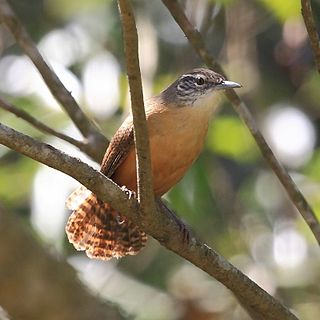
The swallow-winged puffbird is a species of near-passerine bird in the family Bucconidae, the puffbirds, nunlets, and nunbirds. It is also called the swallow-wing. It is found in Bolivia, Brazil, Colombia, Ecuador, French Guiana, Guyana, Peru, Suriname, and Venezuela.

The semicollared puffbird is a species of near-passerine bird in the family Bucconidae, the puffbirds, nunlets, and nunbirds. It is one of seven species of the genus Malacoptila. It is found in Bolivia, Brazil, and Peru.

The giant wren is a species of bird in the family Troglodytidae. It is found in Mexico and Guatemala.

The bicolored wren is a species of bird in the family Troglodytidae. It is found in Colombia, Venezuela, Guyana, and Brazil.

The band-tailed earthcreeper is a species of bird in the Furnariinae subfamily of the ovenbird family Furnariidae. It is found in Argentina and Chile.

The Rio de Janeiro antwren is a bird in subfamily Thamnophilinae of family Thamnophilidae, the "typical antbirds". It is endemic to Brazil.

The white-chinned thistletail, or colicardo barbiblanco in Ecuador, is a species of bird in the Furnariinae subfamily of the ovenbird family Furnariidae. It is found in Colombia, Ecuador, Peru, and Venezuela.

The marsh antwren is an insectivorous bird in subfamily Thamnophilinae of family Thamnophilidae, the "typical antbirds". It is endemic to southeastern Brazil.

The stripe-throated wren is a species of bird in the family Troglodytidae. It is found in Colombia, Ecuador, and Panama.

The buff-breasted wren is a species of bird in the family Troglodytidae. It is found in the Amazon Basin of northern Brazil and Amazonian Colombia, Ecuador, Peru and northern-border Bolivia, and also the Guianan countries of Guyana, Suriname, and French Guiana. It occurs in non-Amazonian regions of Venezuela and Colombia and its range extends into eastern Panama.

The long-billed wren is a species of bird in the family Troglodytidae. It is endemic to Brazil.

The bay wren is a species of bird in the family Troglodytidae. It is native to southern Central America and northwestern South America.

The speckle-breasted wren is a species of bird in the family Troglodytidae. It is found in Colombia, Ecuador, and Peru.

The superciliated wren is a species of bird in the family Troglodytidae. It is found in Ecuador and Peru.

The stripe-breasted wren is a species of bird in the family Troglodytidae. It is found in Honduras, Nicaragua, Costa Rica, and Panama.

The tepui wren is a species of bird in the family Troglodytidae. It is found in Brazil, Guyana, and Venezuela, where it inhabits high tablelands called tepuis.

The mountain wren is a species of bird in the family Troglodytidae. It is found in the Andes of northwestern Argentina, Bolivia, Colombia, Ecuador, Peru, and western Venezuela.

The robust woodpecker is a species of bird in subfamily Picinae of the woodpecker family Picidae. It is found in Argentina, Brazil, and Paraguay.

The canebrake wren is a species of bird in the family Troglodytidae. It is found in Costa Rica, Nicaragua, and Panama.

The hermit wood wren or Santa Marta wood wren is a species of bird in the family Troglodytidae. It is endemic to the Sierra Nevada de Santa Marta of northern Colombia.























